Mark a Point of Asian Art Augustus Was Changed From Classical Idealism
Goose egg was more of import to a Roman emperor than his epitome.
Augustus of Primaporta, 1st century C.East. (Vatican Museums)
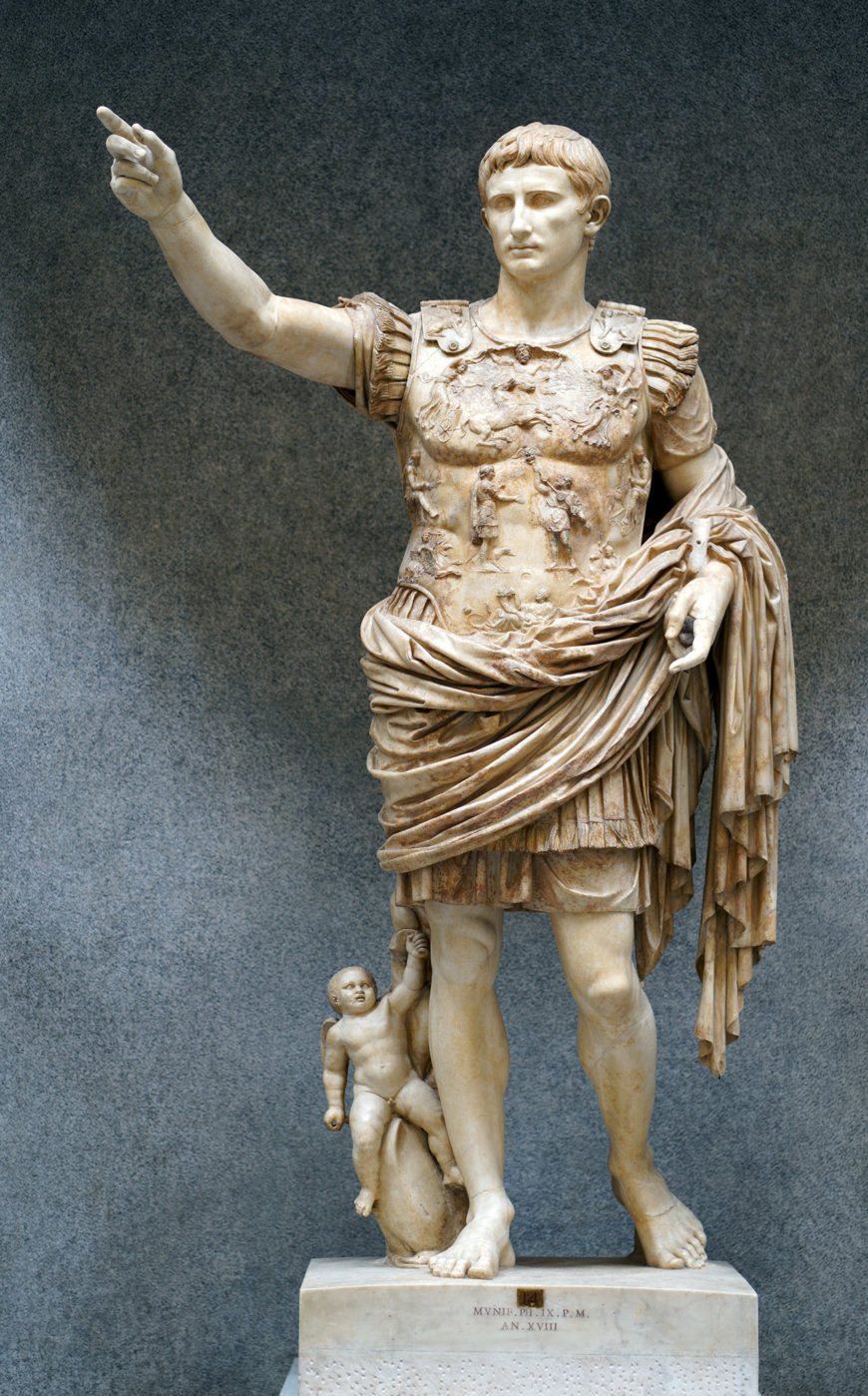
Augustus of Primaporta, 1st century C.E., marble, 2.03 meters high (Vatican Museums) (photo: Steven Zucker, CC By-NC-SA 2.0)
Augustus and the power of images
Today, politicians recollect very carefully about how they will be photographed. Think about all the campaign commercials and print ads we are bombarded with every election season. These images tell us a lot about the candidate, including what they correspond and what agendas they are promoting. Similarly, Roman fine art was closely intertwined with politics and propaganda. This is specially true with portraits of Augustus, the first emperor of the Roman Empire; Augustus invoked the power of imagery to communicate his credo.
Augustus of Primaporta
One of Augustus' nigh famous portraits is the so-called Augustus of Primaporta of 20 B.C.E. (the sculpture gets its name from the town in Italy where it was found in 1863). At outset glance this statue might appear to simply resemble a portrait of Augustus as an orator and full general, but this sculpture likewise communicates a skilful bargain about the emperor's power and credo. In fact, in this portrait Augustus shows himself as a nifty military victor and a staunch supporter of Roman faith. The statue also foretells the 200 yr menses of peace that Augustus initiated, called the Pax Romana.
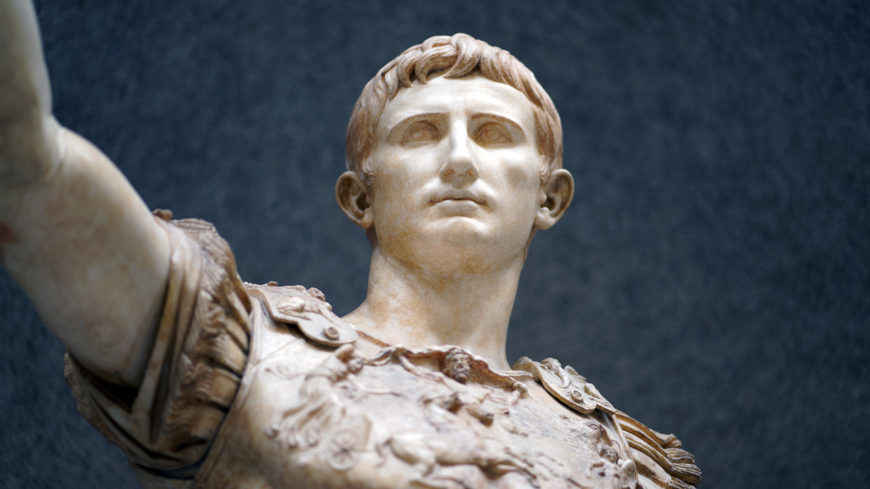
Detail, Augustus of Primaporta, 1st century C.Eastward., marble, 2.03 meters high (Vatican Museums) (photo: Steven Zucker, CC BY-NC-SA 2.0)
Recalling the Gilt Age of ancient Greece
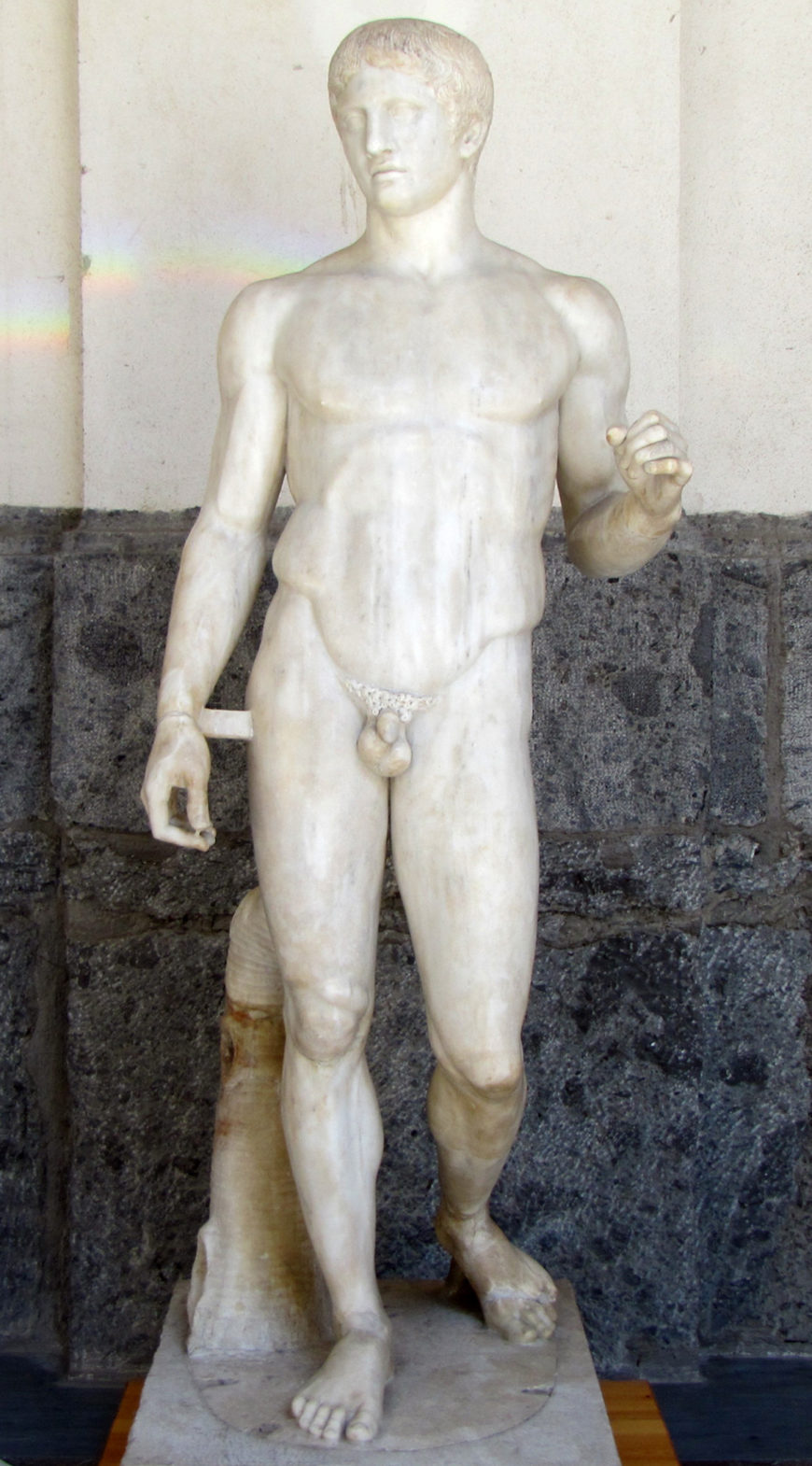
Doryphoros (Spear Bearer), Roman copy later on an original by the Greek sculptor Polykleitos from c. 450–440 B.C.E., marble, 6'6″ (Archaeological Museum, Naples) (photograph: Steven Zucker, CC Past-NC-SA ii.0)
In this marble freestanding sculpture, Augustus stands in a contrapposto pose (a relaxed pose where one leg bears weight). The emperor wears military regalia and his right arm is outstretched, demonstrating that the emperor is addressing his troops. We immediately sense the emperor'southward power as the leader of the army and a armed services conquistador.
Delving farther into the composition of the Primaporta statue, a distinct resemblance to Polykleitos' Doryphoros, a Classical Greek sculpture of the 5th century B.C.E., is apparent. Both take a similar contrapposto stance and both are idealized. That is to say that both Augustus and the Spear-Bearer are portrayed as youthful and flawless individuals: they are perfect. The Romans often modeled their art on Greek predecessors. This is significant because Augustus is substantially depicting himself with the perfect torso of a Greek athlete: he is youthful and virile, despite the fact that he was heart-aged at the time of the sculpture's commissioning. Furthermore, by modeling the Primaporta statue on such an iconic Greek sculpture created during the height of Athens' influence and power, Augustus connects himself to the Gilded Age of that previous civilization.
The cupid and dolphin
So far the message of the Augustus of Primaporta is clear: he is an excellent orator and military victor with the youthful and perfect torso of a Greek athlete. Is that all there is to this sculpture? Definitely not! The sculpture contains even more than symbolism. Showtime, at Augustus' correct leg is cupid figure riding a dolphin.
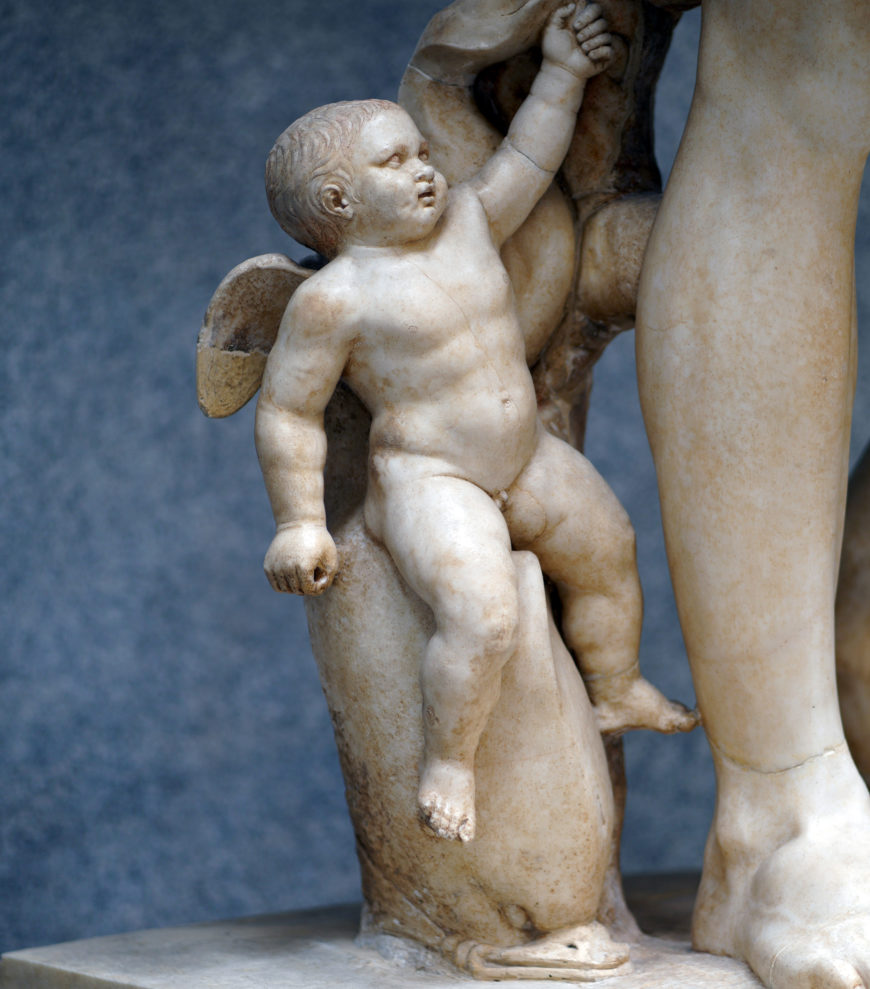
Cupid on a dolphin (detail), Augustus of Primaporta, 1st century C.E., marble, 2.03 meters high (Vatican Museums) (photo: Steven Zucker, CC BY-NC-SA ii.0)
The dolphin became a symbol of Augustus' bang-up naval victory over Marker Antony and Cleopatra at the Battle of Actium in 31 BCE, a conquest that made Augustus the sole ruler of the Empire. The cupid astride the dolphin sends some other message too: that Augustus is descended from the gods. Cupid is the son of Venus, the Roman goddess of love. Julius Caesar, the adoptive male parent of Augustus, claimed to exist descended from Venus and therefore Augustus besides shared this connection to the gods.
The breastplate
Finally, Augustus is wearing a cuirass, or breastplate, that is covered with figures that communicate additional propagandistic letters. Scholars debate over the identification over each of these figures, but the basic significant is clear: Augustus has the gods on his side, he is an international military victor, and he is the bringer of the Pax Romana, a peace that encompasses all the lands of the Roman Empire.
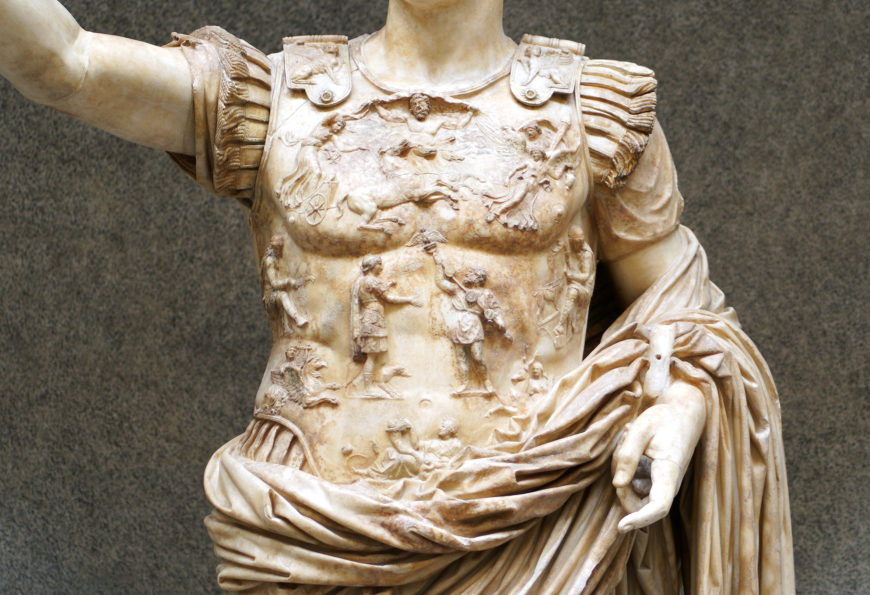
Item of the breastplate, Augustus of Primaporta, 1st century C.Due east., marble, ii.03 meters high (Vatican Museums) (photo: Steven Zucker, CC BY-NC-SA ii.0)
In the central zone of the cuirass are two figures, a Roman and a Parthian. On the right, the enemy Parthian returns military standards. This is a straight reference to an international diplomatic victory of Augustus in 20 B.C.E., when these standards were finally returned to Rome subsequently a previous battle.
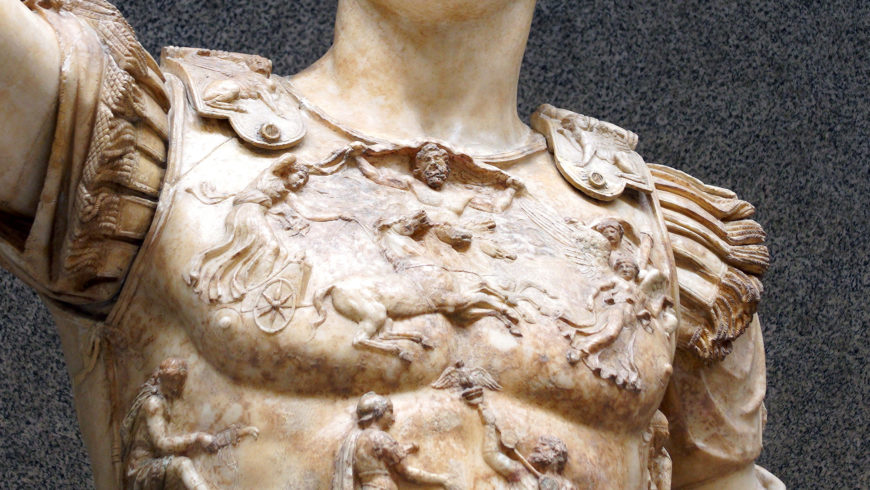
Particular of Sol and Caelus on the breastplate, Augustus of Primaporta, 1st century C.E., marble, ii.03 meters high (Vatican Museums) (photograph: Steven Zucker, CC By-NC-SA two.0)
Surrounding this central zone are gods and personifications. At the top are Sol and Caelus, the sun and sky gods respectively. On the sides of the breastplate are female person personifications of countries conquered by Augustus. These gods and personifications refer to the Pax Romana. The message is that the sun is going to shine on all regions of the Roman Empire, bringing peace and prosperity to all citizens. And of course, Augustus is the 1 who is responsible for this abundance throughout the Empire.
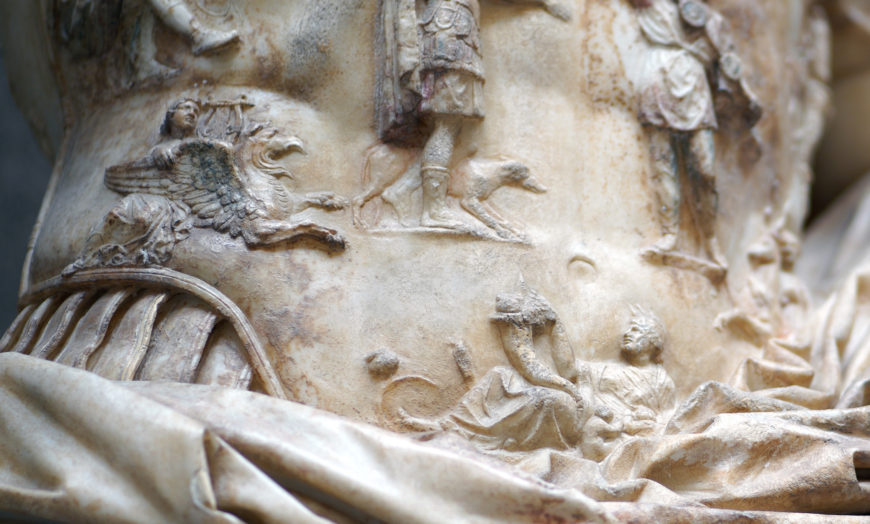
Particular of Tellus on the breastplate, Augustus of Primaporta, 1st century C.E., marble, ii.03 meters loftier (Vatican Museums) (photo: Steven Zucker, CC By-NC-SA 2.0)
Beneath the female personifications are Apollo and Diana, 2 major deities in the Roman pantheon; clearly Augustus is favored by these important deities and their appearance here demonstrates that the emperor supports traditional Roman faith. At the very lesser of the cuirass is Tellus, the world goddess, who cradles ii babies and holds a cornucopia. Tellus is an additional allusion to the Pax Romana as she is a symbol of fertility with her healthy babies and overflowing horn of plenty.
Not but a portrait
The Augustus of Primaporta is one of the ways that the ancients used fine art for propagandistic purposes. Overall, this statue is non simply a portrait of the emperor, information technology expresses Augustus' connexion to the past, his role as a military machine victor, his connection to the gods, and his role as the bringer of the Roman Peace.
Additional resources:
View this work at the Vatican Museums
D. E. Due east. Kleiner, Roman Sculpture (New Haven: Yale University Printing, 1994).
Paolo Liverani, The Augustus of Prima Porta: Report on the Polychromy (2011) on The Digital Sculpture Project
John Pollini,From Democracy to Empire: Rhetoric, Religion, and Ability in the Visual Culture of Aboriginal Rome (Norman: Academy of Oklahoma Press, 2012).
Paul Zanker,The Ability of Images in the Age of Augustus (Ann Arbor: University of Michigan Press, 1990).
Suetonius,The Lives of the Twelve Caesarson Perseus Digital Library
Smarthistory images for teaching and learning:
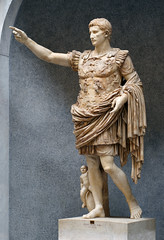
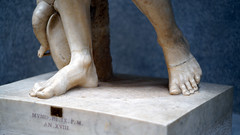


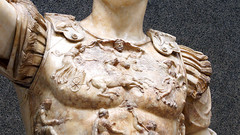
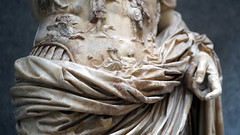
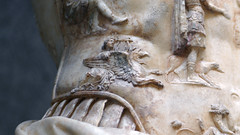
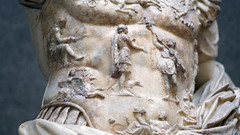
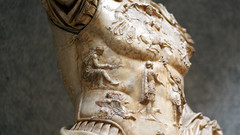
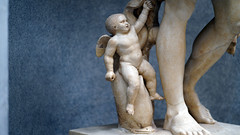

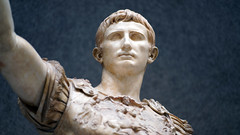
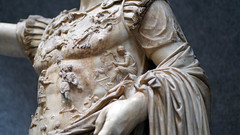
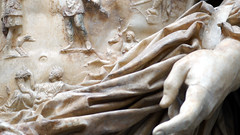
More than Smarthistory images…
Source: https://smarthistory.org/augustus-of-primaporta/
0 Response to "Mark a Point of Asian Art Augustus Was Changed From Classical Idealism"
Post a Comment